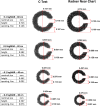Possible limits of calibrating reading charts with the Landolt ring: a microscopic study
- PMID: 35965343
- PMCID: PMC9377069
- DOI: 10.1186/s40662-022-00302-5
Possible limits of calibrating reading charts with the Landolt ring: a microscopic study
Abstract
Purpose: To evaluate microscopically whether the print quality and accuracy of sizing of Landolt ring near vision charts are adequate for the calibration of reading charts.
Methods: Near vision charts with Landolt rings from Oculus GmbH (C-Test; Wetzlar, Germany), Precision Vision (Woodstock, IL) and the RADNER Charts were examined, as well as custom-made Landolt rings optimized for print quality. Microscopic investigations and measurements were performed by using a Huvitz HSZ 600 stereomicroscope (Nikon NIS Elements software) to evaluate the height of the Landolt rings, the thickness of the lines, and the width of the openings. The deviations from the mathematically correct values, which were calculated as given in the EN/ISO 8596 and by the International Council of Ophthalmology (ICO), were analyzed (calculated for a test distance of 40 cm).
Results: All the near vision charts showed notable deficiencies in print quality and aberrations from the nominal values in the height, thickness of the lines, and width of the openings. The openings were too narrow, whereas the height and thickness of the lines were larger than the nominal values. Even the openings of Landolt rings optimized for print quality were not always within an acceptable 5% tolerance and need further improvement.
Conclusion: This study reports inaccuracies in the heights, thicknesses of the lines, and widths of the openings of Landolt rings in all the near vision charts investigated. The extent of these inaccuracies excludes such near vision charts as reference tests for the calibration of reading charts. The x-height in relation to the visual angle still seems to be the most reliable method for standardizing the print sizes for reading charts.
Keywords: Landolt rings; Near vision charts; Near visual acuity; Print quality; Reading acuity; Sizes of optotypes.
© 2022. The Author(s).
Conflict of interest statement
W. Radner receives royalties for the RADNER Reading Charts and the Oculus Reading probe II (German). There are no other conflicts of interest.
Figures


Similar articles
-
[Ophthalmologic reading charts : Part 2: Current logarithmically scaled reading charts].Ophthalmologe. 2016 Dec;113(12):1029-1035. doi: 10.1007/s00347-015-0175-7. Ophthalmologe. 2016. PMID: 26586550 Review. German.
-
[Comparison of visual acuity measurement with Landolt rings versus numbers].Ophthalmologe. 2019 Nov;116(11):1058-1063. doi: 10.1007/s00347-019-0879-1. Ophthalmologe. 2019. PMID: 30927070 German.
-
[Ophthalmological reading tests : Part 1: historical aspects].Ophthalmologe. 2016 Nov;113(11):918-924. doi: 10.1007/s00347-015-0174-8. Ophthalmologe. 2016. PMID: 26645991 Review. German.
-
Reading charts in ophthalmology.Graefes Arch Clin Exp Ophthalmol. 2017 Aug;255(8):1465-1482. doi: 10.1007/s00417-017-3659-0. Epub 2017 Apr 14. Graefes Arch Clin Exp Ophthalmol. 2017. PMID: 28411305 Free PMC article. Review.
-
Toward an internationally accepted standard for reading charts.Prog Retin Eye Res. 2024 Jul;101:101262. doi: 10.1016/j.preteyeres.2024.101262. Epub 2024 Apr 2. Prog Retin Eye Res. 2024. PMID: 38574851 Review.
References
-
- Colenbrander A. Consilium Ophthalmologicum Universale Visual Functions Committee, visual acuity measurement standard. Ital J Ophthalmol. 1988;11:5–19.
LinkOut - more resources
Full Text Sources
Research Materials

